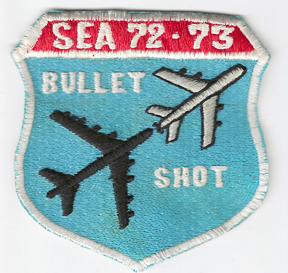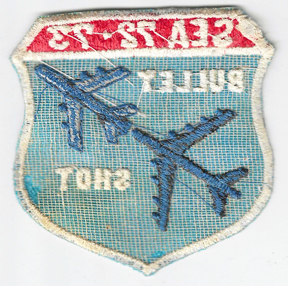Vietnam Era US Air Force Operation Bullet Shot B-52 Build-up SEA 1972-73 Squadron Patch. Thai machine embroidered. Uused.
Found on the internet:
Operation Bullet Shot
Operation Bullet Shot was the codename for the buildup of B-52 bombers and supporting elements in Southeast Asia as part of efforts to counteract North Vietnamese pressure on South Vietnam. In May 1968, the United States had begun negotiations with the North Vietnamese in Paris and had subsequently started to draw down the total US forces in South Vietnam. President Nixon, however, made sure to indicate that the United States would respond militarily to any overt action against South Vietnam.
In February 1972, 29 B-52s from Andersen Air Force Base, Guam and 10 KC-135s from Kadena Air Base, Japan were deployed to Southeast Asia as part of Operation Bullet Shot. These aircraft were deployed to U Tapao Air Base, Thailand. An additional 30 B-52 aircraft were deployed under Operation Bullet Shot to Andersen Air Force Base.
Following the beginning of North Vietnam's Nguyen Hue Offensive in March 1972 (known also as the Easter Offensive), additional assets were deployed to Southeast Asia under Bullet Shot II and Bullet Shot III. Under Bullet Shot II, 6 KC-135s were deployed to Southeast Asia in April 1972. This was later expanded to include another 3 aircraft. Under Bullet Shot III, also in April 1972, 3 KC-135s were deployed to Kadena Air Base and another 7 were sent to U Tapao. In May 1972, another 2 KC-135s were deployed to Kadena Air Base.
By 23 May 1972, a total force of 210 B-52D and B-52G aircraft were deployed in East Asia, which at the time was more than one-half of Strategic Air Command's entire strategic bomber force. By July 1972 a force of almost 50 B-52Ds, 100 B-52Gs, and over 12,000 personnel were bedded down at Anderson Air Force Base. These bombers and support aircraft participated in bombing raids against enemy targets all over Vietnam, including north of the demilitarized zone.
The buildup provided aircraft to support Operation Linebacker II, which began in December 1972 and is often credited with finally bringing the Paris peace talks to their conclusion. The B-52 sortie rate as part of Arc Light operations had been reduced to 1,000 per month in July 1971, and was increased to 1,200 per month in February 1972. When Operation Bullet Shot was complete, the B-52s were capable of 3,150 sorties a month, until President Richard M. Nixon ordered a cessation to the aggressive bombing efforts. President Nixon gave that order when it appeared that the Paris Peace Talks were resulting in a possible agreement. However, when the communist forces took advantage of the bombing halt by increasing their operations tempo, President Nixon gave the order to execute Linebacker II.




